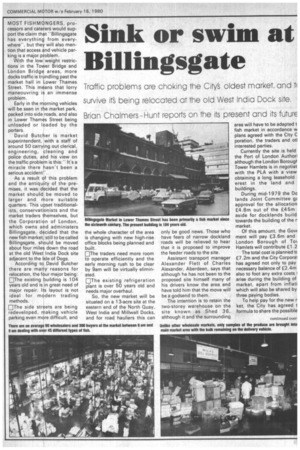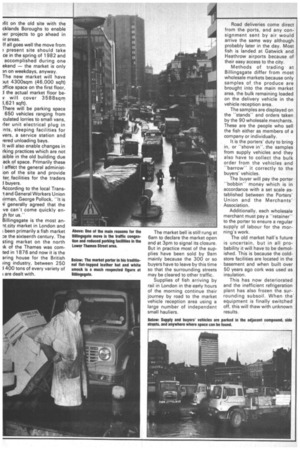Sink or swim at Billingsgate
Page 57

Page 58

If you've noticed an error in this article please click here to report it so we can fix it.
Traffic problems are choking the City's oldest market, and t( survive -f's being relocated at the old West India Dock site. Brian Chalmers-Hunt reports on the its present and its future MOST FISHM NGERS, processors and cate ers would support the claim th t "Billingsgate has everythin from everywhere", but the will also mention that access nd vehicle parking is a major p oblem.
With the low weight restrictions in the To er Bridge and London Bridg areas, more docks traffic is tr ndling past the market hall in ower Thames Street. This m ans that lorry maneouvring an immense problem.
Early in the morning vehicles will be seen in t e market park, packed into side roads, and also in Lower Tham s Street being unloaded or I aded by the porters.
David Bute er is market superintendent, with a staff of around 50 carry ng out clerical, engineering, leaning and police duties, a d his view on the traffic proble is this:" It's a miracle there asn't been a serious accident As a result f this problem and the antiqu ty of the premises, it was d cided that the market should be moved to larger and ore suitable quarters. This u set traditionalists, conservati nists and the market traders hemselves, but the Corporati n of London, which owns a d administers Billingsgate, d cided that the new fish market still to be called Billingsgate, sh uld be moved about four mile down the road at the old West India Dock site adjacent to the I le of Dogs.
According to David Butcher there are ma y reasons for relocation, the f ur major being: The existing •uilding is 104 years old and is in great need of major repair. I s layout is not ideal for m dern trading methods.
The side str redeveloped, parking even m ets are being aking vehicle re difficult, and the whole character of the area is changing with new high-rise office blocks being planned and built.
The traders need more room to operate efficiently and the early morning rush to be clear by 9am will be virtually eliminated.
The existing refrigeration plant is over 50 years old and needs major overhaul.
So, the new market will be situated on a 13-acre site at the eastern end of the North Quay, West India and Millwall Docks, and for road hauliers this can only be good news. Those who have fears of narrow dockland roads will be relieved to hear that it is proposed to improve the feeder roads to the site.
Assistant transport manager Alexander Flett of Charles Alexander, Aberdeen, says that although he has not been to the proposed site himself many of his drivers know the area and have told him that the move will be a godsend to them.
The intention is to retain the two-storey warehouse on the site known as Shed 36, although it and the surrounding area will have to be adapted t fish market in accordance w plans agreed with the City C poration, the traders and otl interested parties.
Currently the site is held the Port of London Authori although the London Borougf Tower Hamlets is in negotiat with the PLA with a view obtaining a long leasehold erest in the land and buildings.
During mid-1979 the Do lands Joint Committee approval for the allocation £4.8m out of the £45m aside for docklands build towards the building of the r market.
Of this amount, the Govt ment will pay £3.6m and London Borough of To Hamlets will contribute E.1.2 The total cost is planned tc £.7.2m and the City Corporal has agreed not only to pay necessary balance of E2.4m also to foot any extra costs I arise during the building of market, apart from inflati which will also be shared by three paying bodies.
To help pay for the new r ket, the City has agreed t formula to share the possible >fit on the old site with the cklands Boroughs to enable ter projects to go ahead in ir areas.
If all goes well the move from present site should take ce in the spring of 1982 and accomplished during one ekend — the market is only 3n on weekdays, anyway. The new market will have nit 4300sqm (46,000 sqft) affice space on the first floor, the actual market floor bev will cover 3588sqm 3,621 sqft).
There will be parking space 650 vehicles ranging from culated lorries to small vans, ,fer unit electrical plug in nts, sleeping facilities for vers, a service station and fered unloading bays.
It will also enable changes in rking practices which are not ;sible in the old building due ack of space. Primarily these I affect the general administon of the site and provide ter facilities for the traders buyers.
According to the local Trans. 't and General Workers Union iirman, George Pollock, "It is iv generally agreed that the ve can't come quickly enjh for us."
Billingsgate is the most an it city market in London and ; been primarily a fish market the sixteenth century. The sting market on the north lk of the Thames was comted in 1876 and now it is the aring house for the British ling industry, between 250 1 400 tons of every variety of i are dealt with. The market bell is still rung a 6am to declare the market open and at 3pm to signal its closure. But in practice most of the supplies have been sold by 9am mainly because the 300 or so buyers have to leave by this time so that the surrounding streets may be cleared to other traffic.
Supplies of fish arriving by rail in London in the early hours of the morning continue their journey by road to the market vehicle reception area using a large number of independent small hauliers, Road deliveries come direct from the ports, and any consignment sent by air would arrive the same way although probably later in the day. Most fish is landed at Gatwick and Heathrow airports because of their easy access to the city.
Methods of trading at Billingsgate differ from most wholesale markets because only samples of the produce are brought into the main market area, the bulk remaining loaded on the delivery vehicle in the vehicle reception area.
The samples are displayed on the "standsand orders taken by the 90 wholesale merchants. These are the people who sell the fish either as members of a company or individually.
It is the porters' duty to bring in, or "shove in", the samples from supply vehicles and they also have to collect the bulk order from the vehicles and "barrow" it correctly to the buyers' vehicles.
The buyer will pay the porter "bobbin" money which is in accordance with a set scale established between the Porters' Union and the Merchants' Association.
Additionally, each wholesale merchant must pay a "retainer" to the porter to ensure a regular supply of labour for the morning's work.
The old market hall's future is uncertain, but in all probability it will have to be demolished. This is because the coldstore facilities are located in the basement and when built over 50 years ago cork was used as insulation.
This has now deteriorated and the inefficient refrigeration plant has also frozen the surrounding subsoil. When the' equipment is finally switched off, this will thaw with unknown results.
























































































































